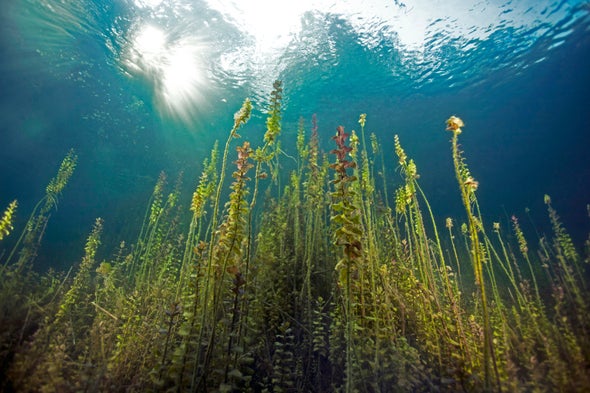Scientists have known for some time the ocean is acidifying because of climate change. The seas’ absorption of human-generated carbon dioxide from the atmosphere is well documented, along with the harm it is causing ocean creatures like shellfish.
But what about freshwater? Is it also soaking up atmospheric carbon? A new paper published today in Current Biology presents some of the first evidence that the answer may be yes, but perhaps not the same way as occurs in the ocean.
In the new study researchers reported a significant increase of CO2 and a correlating pH decrease of about 0.3 in four reservoirs in Germany over 35 years. They analyzed data collected from 1981 to 2015 by the local Ruhr region agency that monitors drinking water, and were able to document the rising carbon dioxide levels over time by factoring in changes in temperature, water density, pH, ion species distribution and total inorganic content.
A crucial reason why the study of freshwater acidification has lagged until now is because determining how atmospheric carbon affects these ecosystems requires complex modeling, and is much less clear than that occurring in oceans, according to study author Linda Weiss, an aquatic ecologist at Ruhr University Bochum in Germany. In oceans CO2 from the atmosphere dissolves into seawater’s surface, forming carbonic acid. Freshwater such as lakes, though, receive various sources of carbon dioxide from decomposing organic and inorganic matter swept into them, which makes it hard for scientists to distinguish between the direct effects of rising atmospheric CO2 and these other elements.
Carbon dioxide levels in lakes are often high and vary widely from lake to lake based on factors such as the type of nearby ecosystem, land use such as agriculture, sizes of the lake and watershed, amount of precipitation, and because some types of soils and rocks absorb more CO2 than others. Levels of CO2 also shift seasonally, changing as leaves drop in fall and ice forms in winter or as animals go through their life cycles, and even daily, rising at night due to temperature changes and algae’s inability to photosynthesize at night. All of this makes it harder to discern long-term trends. The data set Weiss used was unusual in that it monitored these myriad factors over the 35-year period, allowing the researchers to conclude the increase in CO2 they saw in the reservoirs was indeed due to increased carbon dioxide in the atmosphere.
The primary way freshwater ecosystems absorb CO2 created by humans burning fossil fuels is likely different than what happens in oceans. In lakes and reservoirs the extra atmospheric CO2 feeds the surrounding vegetation and the rising global temperature lengthens the growing season. As plants in and around the lake grow larger and/or proliferate, the amount of organic carbon available when they die and the rate at which they break down in soil increases. Precipitation then washes it into lakes and other freshwater systems.
Although some lakes can also absorb CO2 at their surfaces similar to the way oceans do, the increases in these other sources of organic and inorganic carbon are likely the dominant factor, says Scott Higgins, a research scientist at the International Institute for Sustainable Development’s Experimental Lakes Area, a natural laboratory of 58 small lakes in Ontario. In fact, some lakes have more CO2 than the atmosphere, so they release CO2 from the water into the air, he says.
For their study, Weiss and her team also documented the impacts of higher CO2 levels on freshwater crustaceans at the bottom of the food web—specifically, two species of Daphnia, also known as water fleas. Multiple studies have shown increased CO2 makes it more difficult for ocean animals to form shells as well as dulls their senses, making them more vulnerable to predators. A few studies have shown similar impacts on freshwater species in the lab. But Daphnias, Weiss’s critters of interest, had not been studied.
When Daphnias sense predators, they raise a helmet and deploy spikes, called “neckteeth,” to protect themselves. To test how rising CO2 might affect their defense mechanism, Weiss exposed stock Daphnias in the lab to levels of CO2 ranging from just above the maximum level seen in global freshwater to about 60 percent more than that maximum, to mimic a worst-case scenario. The researchers found that when exposed to higher CO2 levels, the critters were less able to sense predators and deploy their defenses.
Weiss says she used lab animals because they are well studied: “We know what they do or what they’re supposed to do.” But Higgins notes that could create misleading results: The animals Weiss tested had never been exposed to such high CO2 concentrations before. That is likely different than the experiences of wild animals, who have to adapt to the regularly changing carbon dioxide levels of lakes and reservoirs from season to season and throughout the day. “Over time, lakes are experiencing quite variable CO2 concentrations, and all the biota that live in them are, too,” he says. Although still unknown, it may be that living in such complex water chemistry will ultimately help freshwater plants and animals adapt to the planet’s rising CO2 levels.


